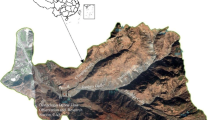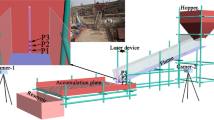Abstract
Non-homogeneous two-phase debris flows are widely found in the western mountainous regions of China. To investigate the characteristics of the debris flow deposition process related to the morphology and extent of the debris fan, a series of physical experiments were carried out using an experimental flume. Some useful relationships were obtained to link the flow velocity with the geometric characteristics of deposition morphology and the corresponding area or volume. Based on these, some expressions about energy dissipation process in both the transport-deposition zone and deposition zone are presented, and improved equations describing solid-liquid two-phase energy transformations in the specific deposition zone are also established. These results provide a basis for further investigating the underlying mechanisms of non-homogeneous debris flows, based upon which effective disaster control measures can be undertaken.
Similar content being viewed by others
References
Bagnold R (1954) Experiments on a gravity-free dispersion of large solid spheres in a Newtonian fluid under shear. Proceedings of the Royal Society of London 225 (1160): 49–63. DOI: 10.1098/rspa.1954.0186
Bagnold R (1956) The flow of cohensionless grains in fluids. philosophical Transactions of the Royal Society of London, Series A. Mathematical and Physical Sciences A 249 (964): 235–297. DOI: 10.1098/rsta.1956.0020
Fei X, Shu A (2004) Movement Mechanism and Disaster Control for Debris Flow. Tsinghua University Press, Beijing. (In Chinese)
Fei X, Xiong G (1995) Debris flow energy dissipation of sediment transportation and calculation method of velocity of flow and resistance. Journal of Sediment Research 12 (4): 1–8. (In Chinese)
Gray J, Kokelaar B (2010) Large particle segregation, transport and accumulation in granular free-surface flows. Journal of Fluid Mechanics 652: 105–137. DOI: 10.1017/s002211201 000011x
Hashimoto H (1990) Model of deposition of grains from debris flow. Hydraulics/Hydrology of Arid Lands ASCE 537–542.
Jiang H, Deng Y, Yuan T (2012) Debris flow formation and dynamic characteristics in Jiabagou of Xiaojin County. Ground Water 34 (2): 149–152.
Jiskoot H, Boyle P, Murray T (1998) The incidence of glacier surging in Svalbard: evidence from multivariate statistics. Computers and Geoscience 24 (4): 387–399. DOI: 10.1016/ s0098-3004 (98)00033-8
Keylock C (2005) An alternative form for the statistical distribution of extreme avalanche runout distances. Cold Regions Science and Technology 42: 185–193. DOI: 10.1016/ j.coldregions.2005.01.004
Kokelaar B, Graham R, et al. (2014) Fine-grained linings of leveed channels facilitate runout of granular flows. Earth and Planetary Science Letters 385: 172–180. DOI: 10.1016/j.epsl.2013.10.043
Liu J, Ou G, You Y (2006) Experimental research on velocity of flow of debris flow and deposition pattern. Research of Soil and Water Conservation 1: 120–123. (In Chinese)
Major J (1997) Depositional processes in large-scale debris-flow experiments. The Journal of Geology 105 (3): 345–366. DOI: 10.1086/515930
Qian N, Wan Z (2003) Mechanics of sediment movement. Science Press, Beijing, China. pp 192–196 (In Chinese)
Shu A, Fei X (2008) Sediment transport capacity of hyperconcentrated flow. Science in China Series G: Physics, Mechanics & Astronomy 51 (8): 961–975. DOI: 10.1007/ s11433-008-0108-4
Shu A (2010) Investigation on movement characteristics for non-homogeneous and solid-liquid two-phase debris flow. Chinese Science Bulletin 55: 3006–3012. DOI: 10.1360/ 972010-741 (In Chinese)
Takahashi T (1981) Debris flow. Annual Review of Fluid Mechanics 13 (1): 57–77. DOI: 10.1146/annurev.fl.13.010181.000421
Tang C, Liu X (1993) Models for dynamic deposition simulation and dangerous area prediction of debris flow. Journal of Soil and Water Conservation 5: 37–40. (In Chinese)
Tang C, Zhu J, Chang M, et al. (2012) An empirical-statistical model for predicting debris-flow runout zones in the Wenchuan earthquake area. Quartenary International 250: 63–73. DOI: 10.1016/j.quaint.2010.11.020
Vallance J, Scott K (1997) The Osceola mudflow from mount rainier: sedimentology and hazard implications of a huge clay-rich debris flow. The Geological Society of America Bulletin 109 (2): 143–163. DOI: 10.1130/0016-7606 (1997)109 <0143:tomfmr>2.3.co;2
Vincenzo D, Cesca M, Marchi L (2010) Field and laboratory investigations of runout distances of debris flows in the Dolomites (Eastern Italian Alps). Geomorphology 115 (3-4): 294–304. DOI: 10.1016/j.geomorph.2009.06.032
Wang G, Shao S, Fei X (1998) Debris flow simulation 2: Verification. Journal of Sediment Research 3: 14–17. (In Chinese)
Wang Z (2001) Experimental researches of debris flow tap movement and energy theories. Journal of Hydraulic Engineering 3: 18–26. (In Chinese)
Wang Z, Cui P, Yu B (2001) Movement mechanism and antidrag of debris flow. Journal of Natural Disasters 10 (3): 37–43. (In Chinese)
Yang Z (2003) Analysis on deposition state on debris flow. Chinese Journal of Rock Mechanics and Engineering 22: 2778–2782. (In Chinese)
Yu G, Zhang M, Wei X, Bi Y (2011) Analysis on the hydrodynamic conditions for the massive debris flow in Sanyanyu based on ArcGIS and DEM. Northwestern Geology 44 (3): 53–62. (In Chinese)
Author information
Authors and Affiliations
Corresponding author
Additional information
http://orcid.org/0000-0003-2341-5068
http://orcid.org/0000-0001-6942-0976
http://orcid.org/0000-0002-5168-7477
http://orcid.org/0000-0001-9952-5293
http://orcid.org/0000-0001-7412-459x
Rights and permissions
About this article
Cite this article
Shu, Ap., Tang, C., Zhang, X. et al. Deposition morphology of non-homogeneous debris flow and its energy characteristics. J. Mt. Sci. 12, 1157–1168 (2015). https://doi.org/10.1007/s11629-014-3188-9
Received:
Accepted:
Published:
Issue Date:
DOI: https://doi.org/10.1007/s11629-014-3188-9




